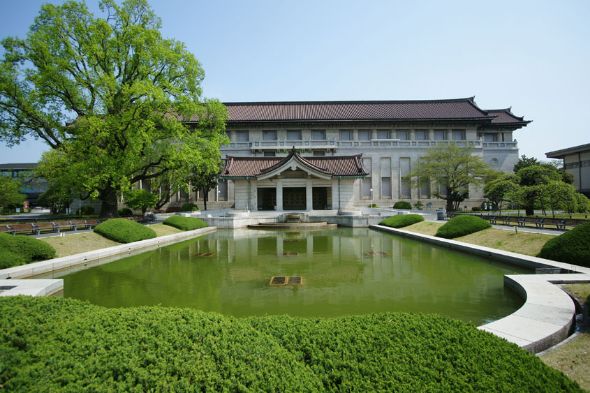Tokyo National Museum: Where Every Visit is a New Discovery
A treasure trove of Japanese culture where displays are rotated 300 times a year
Words by Mari Hashimoto

Each capital city has a museum that serves as the nation’s public face, with many tourists visiting to enjoy their rich collections. As well as housing a zoo, a park, a university and several other cultural institutions, Tokyo’s Ueno district is also home to five national and public museums. When it comes to ancient Japanese art, though, the first port of call has to be Tokyo National Museum (TNM).

The second floor features chronological exhibitions from 10,000 B.C.to the late 19th century. Exhibits are rotated frequently, with several National Treasures also on display in the National Treasure Gallery.
Amassed over 150 years, TNM’s collection comprises over 120,000 objects, including 89 National Treasures and 649 Important Cultural Properties (as of April 2023). TNM has six galleries, with around 3,000 items on permanent display. Unlike museums in other countries, there is no single “must-see” masterpiece at TNM. This is not to say TNM has no outstanding works. Quite the opposite, in fact. Japanese cultural properties are easily damaged by UV light and humidity. To protect them, TNM rotates its regular exhibitions around 300 times a year, which means visitors can encounter many different artworks. TNM is also unique in the way it plans exhibits to match the seasons and seasonal events.

Ukiyo-e portray the lives of commoners during the Edo period (1603–1868). Visitors can view these pictures alongside fashion items that appear within them, such as clothes, sashes, combs, hairpins and hairdressing tools.

This interactive space features replicas of early modern yoroi armor. Viewers can view, touch and feel the weight of armor made of materials like leather, iron, silk and cord. The contents of the hands-on displays are rotated periodically.

This interactive space features a display explaining the nishiki-e multicolored printing technique. Visitors can also create their own multicolor ukiyo-e pictures using stamps. The contents of the hands-on displays are rotated periodically.
One popular exhibit concerns the art of the tea ceremony, and this will be expanded dramatically from 2023 onwards. People around the world have long used tea leaves to brew different types of tea. Tea came to Japan from China in the 9th century, with the practice of tea drinking and cultivation gradually taking root thereafter. By the 16th century, tea had become a central part of Japanese life and the way of tea had developed into a deeply spiritual art form. Simplified versions of the tea ceremony are now held across the globe, giving many people the chance to experience this representative aspect of Japanese culture.
TNM’s Tea Ceremony exhibition room inside the Japanese Gallery (Honkan) features tea utensils, vases, incense containers, tableware, and ornamental paintings and calligraphic works, for instance. These are artfully arranged in a manner similar to an actual tea ceremony, with items chosen to match the seasons or the day’s guests. There are also several teahouses on the grounds where visitors can hold tea bowls, drink tea, and participate in a real tea ceremony.

This room displays utensils from the tea ceremony, a representative Japanese tradition. These are arranged by season or theme. The display had a “moon” theme when we visited, with items selected to match early autumn, a season when the last few furo portable braziers are still burning.

Tea Caddy in Bunrin (Apple) Shape, Known as "Mochizuki"; black glaze, Satsuma ware, Edo period, 17th century. This was a gift of Mr. Matsunaga Yasuzaemon, an industrialist who made his fortune in the electric power industry before becoming a renowned collector of tea ceremony utensils. On the right is the Tea Scoop, Known as "Inaushu-sama", Bamboo, By Katagiri Sekishu, Edo period, 17th century, also gifted by Mr. Matsunaga (on display until October 29, 2023).

Tea Bowl, Named “Furisode (Swinging Sleeves)”, Mino ware, Shino type, Azuchi-Momoyama–Edo period, 16th–17th century. This is a representative Shino type tea bowl. Shino ware pottery first emerged in Gifu Prefecture in the mid-16th century, with its subsequent development also shaped by the ingenuity of tea masters from Kyoto (on display until October 29, 2023).

In the 16th century, just as the tea ceremony was developing into an art form, the world was embarking on the Age of Discovery. Japan’s international exchanges also expanded to encompass not only neighboring countries like China and Korea, but Vietnam, Indonesia and even faraway Portugal and Spain too, with curious new articles brought into the country and hungrily incorporated into the tea ceremony.
This importation, assimilation and adoption of strange new objects is a typically Japanese trait. Tokyo National Museum is a treasure trove of this ‘Japanese’ cultural heritage and it should be visited by anyone wishing to learn about the diversity of Japanese culture.
With the cooperation of:
Mikasa Keiko, Curator of Asian Decorative Arts, Publications Section, Planning Division, Curatorial Planning Department, Tokyo National Museum

TOKYO NATIONAL MUSEUM
- Place
- 13-9 Ueno Park, Taito-ku, Tokyo, 110-8712, Japan
- Time
- 9:30 a.m.-5:00 p.m.
* Last admission 30 minutes before closing.
* Due to the rapid increase of coronavirus (COVID-19) infections in Tokyo, the Museum will close at 5:00 p.m.
* Opening hours for special exhibitions may differ.
* Opening hours for the Research and Information Center may differ.
* Kuroda Memorial Hall is open until 5:00 p.m. - Closed
- Mondays (Excluding holidays. On those days, the Museum will be open on Monday and closed the following day); Year-end holidays: December 25, 2023 – January 1, 2024; December 19, 2023. Subject to change.

